View basket (0 items $0.00)
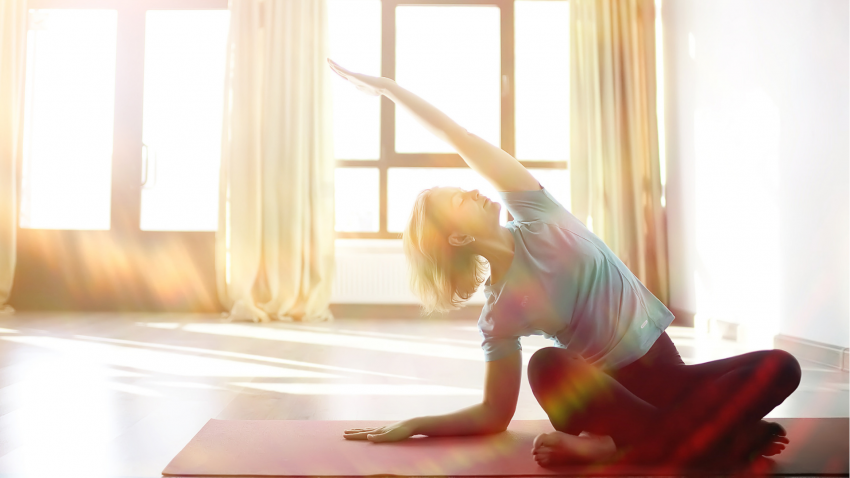
Yoga and Cancer: A Sequence to Help Alleviate Lymphedema
One of the most distressing side effects of cancer treatment is lymphedema, a swelling of the extremities caused by damage to the lymphatic system. The lymphatic system is part of the immune system and consists of nodes, vessels, and organs that transport lymph throughout the body. Lymph transports white blood cells through lymph nodes which are grouped in the throat, underarms, abdomen, and groin. These nodes store cells that help fight infection and filter the lymph before it returns to the bloodstream. If cancer treatment damages or removes lymph nodes, lymph builds up in the surrounding tissue causing painful swelling, or lymphedema.
During breast cancer treatment, lymph nodes are often removed and tested for cancerous cells. The symptoms of lymphedema may occur immediately or up to 5 years after treatment. According to one survey, between 50-75% of women who had lymph nodes removed as part of breast cancer treatment worried about developing the condition while less than 20% developed the condition (1).
Patients with lymphedema can experience a range of symptoms besides swelling of the limb and digits including pain, limited range of motion, increased risk of infection, sensitivity, hardening or thickening of the skin. (2) Lymphedema treatments include manual lymph drainage, elevation of the affected limb, compression garments, breathing exercises, and movement. (3)
Yoga and Lymphedema 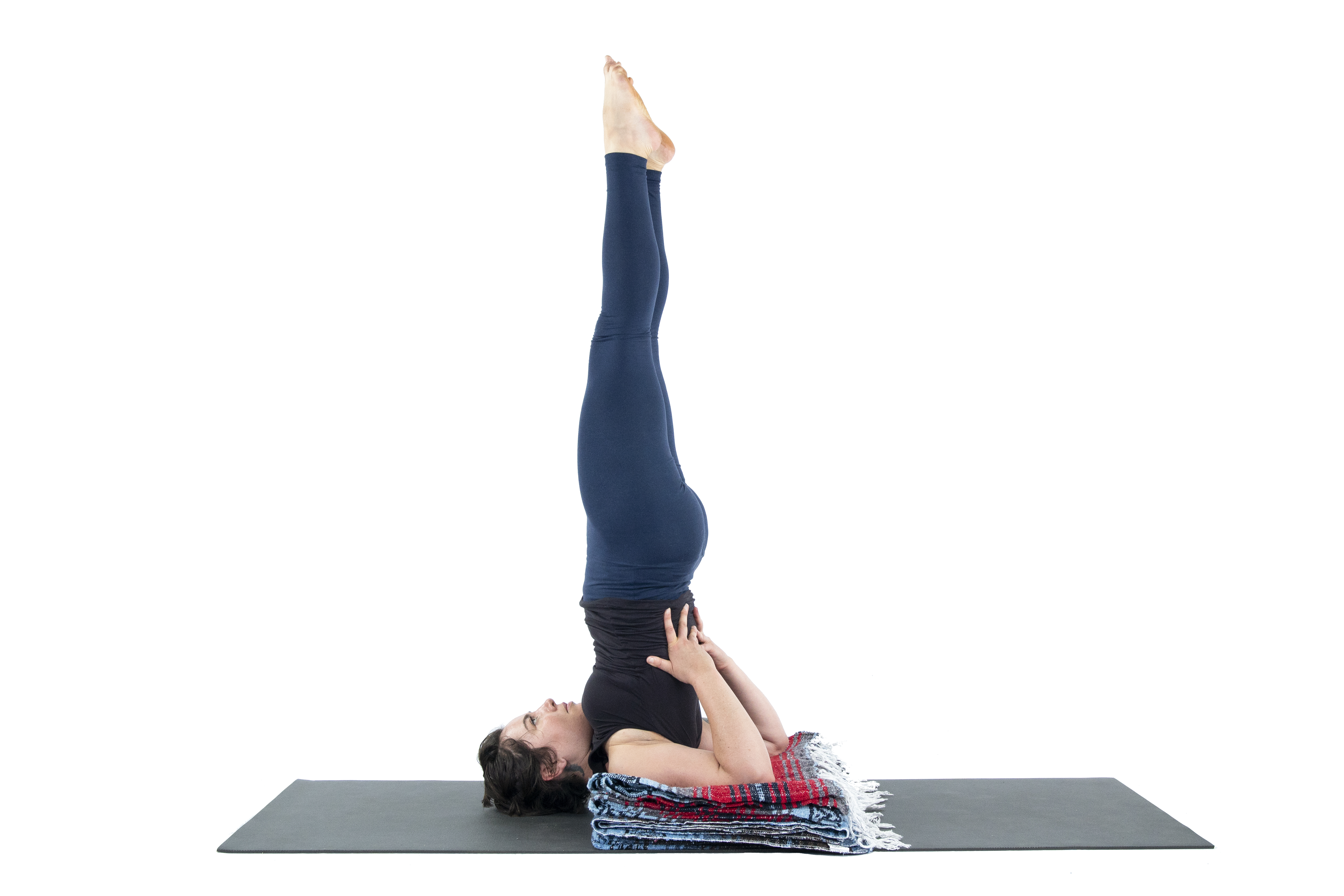
Unlike the circulatory system which has the pumping heart to move blood through the vessels, the lymphatic system relies on the body’s movements to circulate lymph. The deep diaphragmatic breathing and simple repetitive movements of the hands, arms, neck, torso, and hips that are involved in many forms of yoga all help the lymph to flow optimally. Yoga also helps to increase range of motion and strength, which can help to counter the impact of lymphedema, so long as the yoga is practiced slowly and gently.
There are a few yoga poses that are contraindicated for those with lymphedema. These include Adho Mukha Vrksasana (Handstand), Pincha Mayurasana (Forearm Balance Pose), Adho Mukha Svanasana (Downward Facing Dog Pose), Sirsasana (Headstand), Sarvangasana (Shoulderstand) (see photo above right), and Halasana (Plow Pose), which all put too much pressure on the arms, shoulders, and neck and should be avoided. If the lower extremities are affected, poses that create too much compression on the legs should also be avoided such as Padmasana (Lotus Pose) or Balasana (Child’s Pose) with deeply bent knees.
Yoga Practice Tips
-
Do a little yoga each day to give yourself the time and space to heal, and to help make yoga a part of your life after cancer.
-
Stay mindful of the body and breath throughout the practice, and only move in a comfortable range of motion. If you become uncomfortable, dizzy, nauseated or breathless, stop immediately and rest for a few moments.
-
This sequence includes movements that mechanically squeeze and stretch the armpit, abdomen and groin areas to stimulate lymphatic flow.
-
It is important to completely relax the muscles and rest in between active portions of each movement.
-
For this practice, a yoga mat, chair, and a blanket or pillow will be helpful.
Repeat Intention with Anushasana Mudra
One of the tools of yoga is practicing mudras, which link the physical and energy bodies. Here use Anushasana Mudra to activate vyana vayu, the pranic current that moves from the center of the body toward the extremities and supports lymphatic circulation. 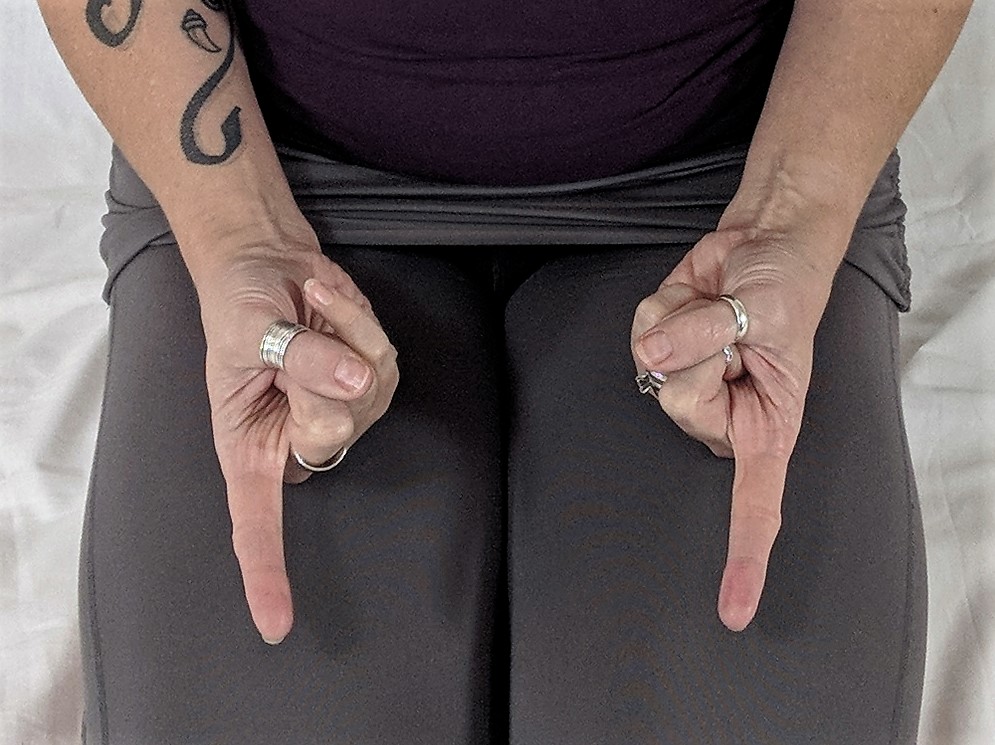
-
Begin in a comfortable seated position.
-
Rest your hands' palms up on your knees.
-
Make a soft fist and extend your index fingers strongly outward.
-
As you hold this mudra imagine that your inhalations draw energy inward from the periphery toward the center of your body
-
As you exhale imagine energy expanding outward from the center of your body toward the edges.
-
Recall your intention and repeat it three times silently or use the intention “My immunity is strong.”
Reclining Floor Yoga Flow
The reclining floor flow is a simple series of movements that massages the lymphatic structures in the armpits, abdomen, and groins. It can also alleviate pain in the hips, lower spine, and shoulders. This practice can be done on the floor or a bed. 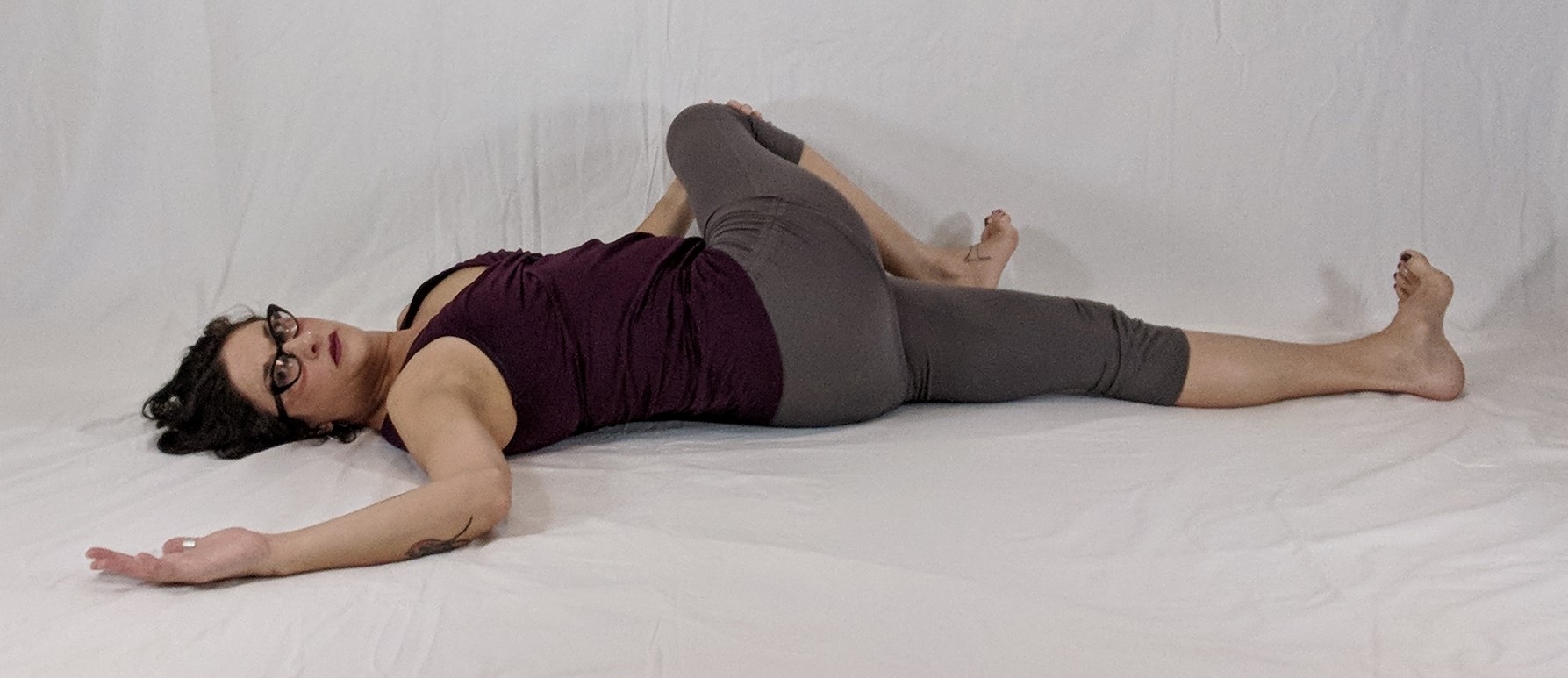
-
Recline with your legs extended. As you inhale, raise your arms over your head to a comfortable position.
-
As you exhale, draw your right knee toward your chest.
-
On your next inhalation, draw your right knee out and open your left arm out from your shoulder.
-
Exhale and pass your knee across your body to your left hand and rotate your pelvis and lower spine to the left, turn your head to the right.
-
Inhale and bring your leg and torso back to the center and extend your right foot upward, clasping your hands behind your thigh.
-
Exhale and draw your knee into your chest.
-
Inhale and return to the starting position with arms extended over your head, and your legs long on the floor. Take a few breaths of rest here.
Repeat the entire sequence of movements with your left leg, alternating sides up to five times each. Be sure to rest for several breaths between each set of flowing movements.
Marjarasana/Bitilasana (Cat/Cow Pose)
This common series of poses is a simple way to move energy and lymph throughout the torso and can be done kneeling on the floor or seated in a chair. 
-
For the kneeling variation, pad the knees with a folded towel or blanket and bring your knees under your hips and hands just in front of your shoulders. If the wrists are uncomfortable, press the fists into the floor with the thumbs forward.
-
From a neutral spinal position exhale and draw your belly in, round your back and release your head to look at your knees; this is Cat Pose. Stay here for a few breaths and feel the stretch of your spinal muscles and the gentle compression of your organs.
-
As you inhale begin to lengthen your pubic bone away from your navel and lift your heart, look forward being careful not to overarch your neck; this is Cow Pose (shown). Stay here for a few breaths feeling the even extension of the spine.
-
Begin to move with your breath, exhale into Cat Pose, inhale into Cow Pose, and then relax into center for a few moments of rest.
-
For the seated variation inhale into Cow Pose, place your hands on your hips, draw your tailbone and shoulder blades back, stretch your abdomen forward, and lift your heart with your gaze going toward the ceiling.
-
Exhale into Cat Pose, draw your belly in and round your entire spine, release your chin toward your chest while you reach out and cup your knees with your hands.
Continue to move and breathe for five more rounds. Be sure to rest for several breaths between each set of flowing movement.
Balasana to Utthita Virasana (Child’s Pose to Extended Hero’s Pose) 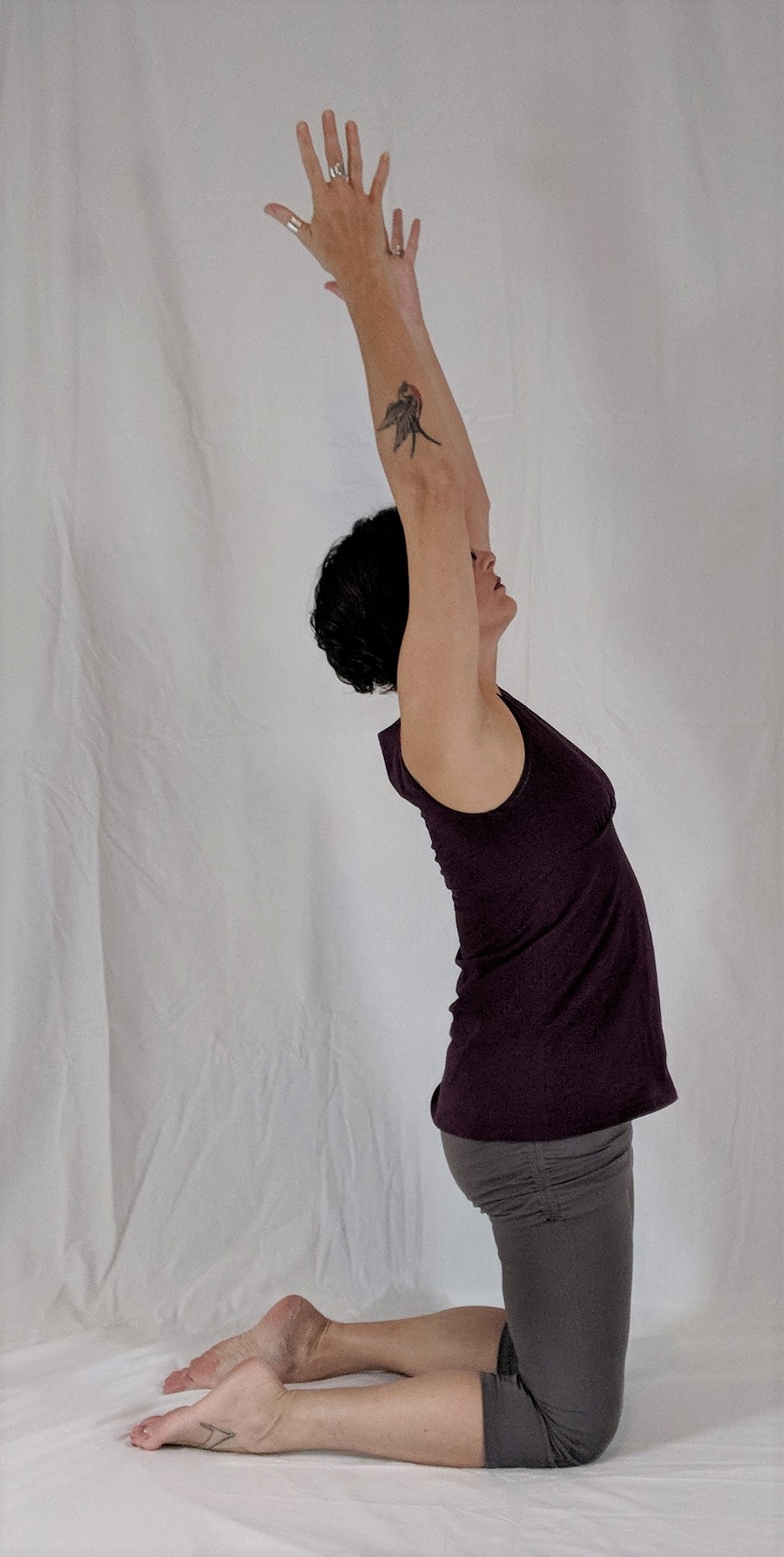
Moving from Child’s Pose (Balasana) to an extended spinal position mobilizes prana, or vital energy in the body and can help to activate stagnant lymph.
-
Begin in an all-fours position, and as you exhale release your hips back toward the heels into a crouched position or Child’s Pose Only go back as far as your knees will comfortably allow.
-
As you inhale lift your head and chest, press your hips forward. Raise your hands to your heart, place them on your head, or reach your arms overhead into Extended Hero’s Pose as shown.
-
Then as you exhale, fold forward placing your hands on the floor or release back into Child’s Pose if that feels comfortable.
-
Take a few moments of rest before inhaling back into Extended Hero’s Pose.
As you repeat this flowing movement five times with the breath, notice how you alternately stretch and compress both the groin, abdomen, and armpits to encourage lymphatic flow.
Dirga (Three-Part Breath)
Breathing deeply is part of traditional lymphedema treatment as it increases the movement of the diaphragm and massages the lymph nodes located deep within the abdominal cavity. The full yogic breath or Three-Part Breath can be practiced while seated in a chair or reclining on the floor or bed. I often imagine the breath like an elevator car moving up and down along an elevator shaft as I practice this pranayama. 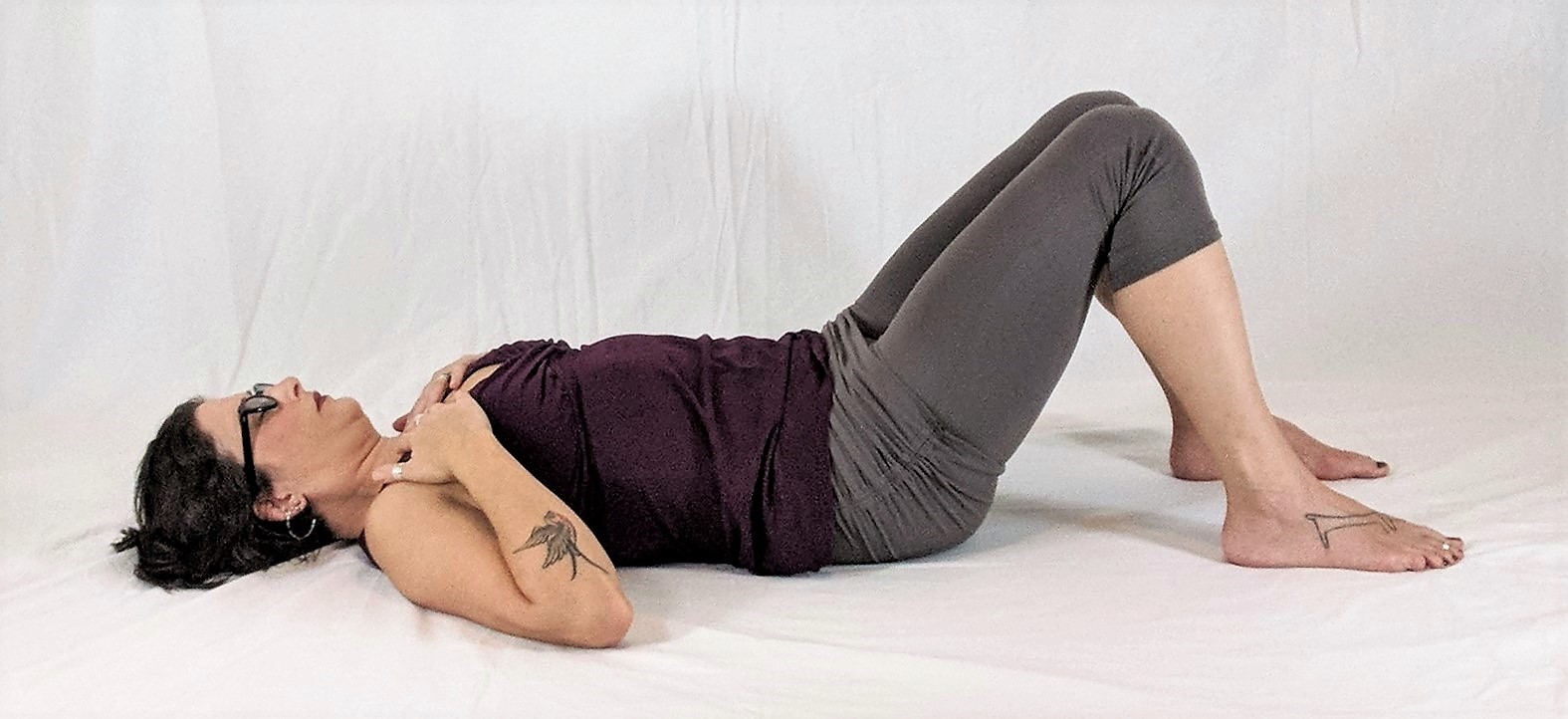
-
As you inhale notice a lifting, buoyant sensation in your torso. As you exhale notice a downward flowing sensation. Maintain these subtle directions as you continue.
-
Inhale the breath from your pelvic floor up to your navel; exhale the breath down to your pelvic floor.
-
Then inhale from your pelvic floor up to your lower ribs. Exhale the breath down from your ribs to your pelvic floor.
-
Then inhale from your pelvic floor up to the top of your chest as if your breath was being poured into your torso and filling you from to bottom to the top. Exhale and release your breath back down to your pelvic floor. It may be helpful to lightly touch the upper chest to provide a bit of feedback for the breath as shown.
Repeat for several more rounds of breath. Then release any control over your breath and rest for a few moments, noticing the effects. Remember to stop and rest if you feel uncomfortable or breathless.
Modified Viparita Karani (Instant Maui Pose) 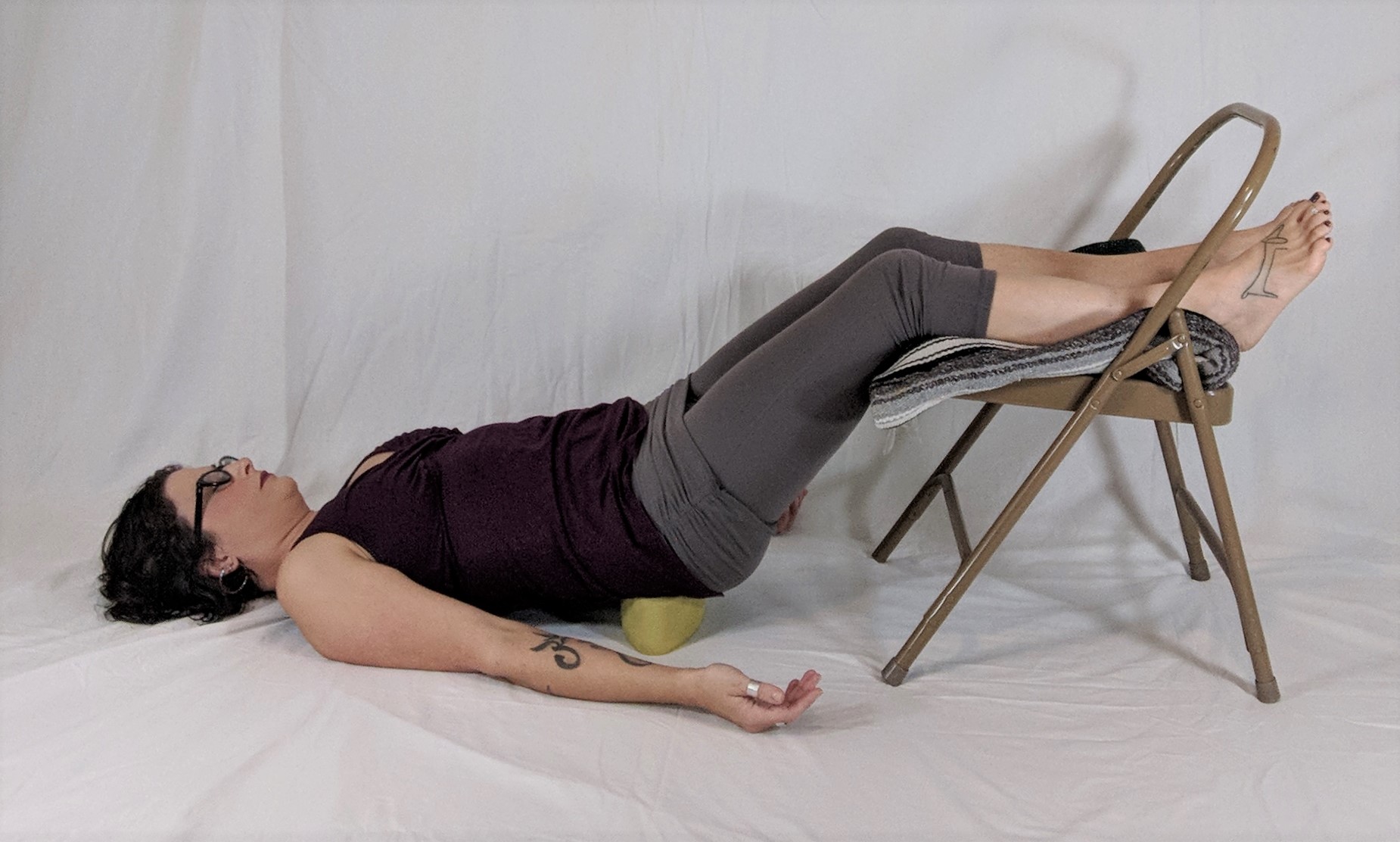
Elevating the legs encourages lymphatic drainage back toward the torso and is very easy to do at home. Some doctors recommend that the legs be elevated above the heart for at least 30 minutes 3-4 times a day for maximum benefit (4). Take care when positioning your body to be sure that your feet are elevated above your knees, your knees above your hips, and your hips above your heart to ensure excess fluid travels back toward the torso where it can be recirculated into the bloodstream.
This posture is also a mild inversion that provides a change in our perspective; and encourages deeper breathing, energy absorption, and relaxation. Find a piece of furniture in your home such as a soft chair, sofa seat or ottoman to use for support.
-
Recline in front of your furniture support and press your feet onto the edge of the seat.
-
Lift your pelvis and place a block, pillow or folded blanket under your hips. The prop should be between the waistband of your pants and the tailbone. If it is too high or too low, it will not feel comfortable so find that sweet spot where your sacrum is parallel to the floor.
-
Rest your arms slightly away from your sides with the palms facing up.
-
If the hips are elevated, it is best not to use a pillow for the head. If you have unmedicated high blood pressure, nausea, or this position makes you feel dizzy or uncomfortable, remove the prop out from under your pelvis and rest with the pelvis flat on the floor.
Rest here for 15 to 30 minutes. Feel free to set a timer if you are concerned that you might fall asleep.
Even though lymphedema can be an uncomfortable side effect of cancer treatment, these simple yoga practices can boost immunity, release tension, increase lymphatic drainage and help the body to find more balance. Happy practicing and namasté.
Here's another article from Cheryl Fenner Brown's series on Yoga for Cancer- Cancer and Insomnia: A Short, Relaxing Sequence to Put You on the Path to Sleep.
Study more about this topic with YogaUOnline and Tari Prinster - Introduction to Yoga for Cancer: Tapping Into the Body's Inherit Healing Wisdom.

 Cheryl Fenner Brown, C-IAYT, ERYT 500 works with cancer patients and people over 50 in central North Carolina. Her 700-hr Hatha training at Piedmont Yoga Studio and 1000-hr Integrative Yoga Therapy training inform her unique blend of alignment principles with subtle energy work, sound, mudra, and yoga nidra. She teaches classes, privates, self-care retreats and enjoys mentoring teachers in a 100-hr Adaptive Yoga Mentorship. Her Healing Yoga for Cancer Survivorship DVD is based on her feasibility study presented at IAYT's Symposium on Yoga Research and the Society of Integrative Oncology's annual conferences in 2015 and highlighted in Yoga Journal. From this work, she developed a 50-hr Healing Yoga for Cancer teacher training that is offered nationwide, find out more at www.yogacheryl.com.
Cheryl Fenner Brown, C-IAYT, ERYT 500 works with cancer patients and people over 50 in central North Carolina. Her 700-hr Hatha training at Piedmont Yoga Studio and 1000-hr Integrative Yoga Therapy training inform her unique blend of alignment principles with subtle energy work, sound, mudra, and yoga nidra. She teaches classes, privates, self-care retreats and enjoys mentoring teachers in a 100-hr Adaptive Yoga Mentorship. Her Healing Yoga for Cancer Survivorship DVD is based on her feasibility study presented at IAYT's Symposium on Yoga Research and the Society of Integrative Oncology's annual conferences in 2015 and highlighted in Yoga Journal. From this work, she developed a 50-hr Healing Yoga for Cancer teacher training that is offered nationwide, find out more at www.yogacheryl.com.
References
Journal of the American College of Surgeons, “Breast Cancer Patients’ Fear Exceeds Risk”, March 2013: Vol 216(3): 380-386.
“Lymphedema”, Mayo Clinic, 2019, https://www.mayoclinic.org/diseases-conditions/lymphedema/symptoms-causes/syc-20374682
Zuther, J., “Yoga for Lymphedema”, Lymphedema Blog, (2017), http://www.lymphedemablog.com/2017/03/02/yoga-for-lymphedema/
Stearns, R. H., “Edema (swelling) (Beyond the Basics), 2019, UpToDate, https://www.uptodate.com/contents/edema-swelling-beyond-the-basics#H17
Featured Courses








